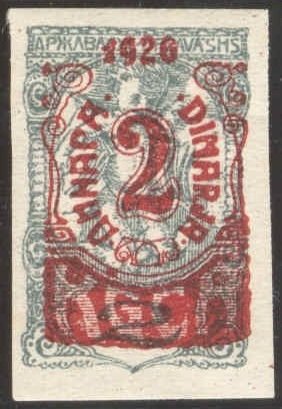Stamp: Carinthia plebiscite - BROWN RED overprint (Slovenia - Kingdom of Serbs, Croats & Slovenes 1920)
Carinthia plebiscite - BROWN RED overprint (Slovenia - Kingdom of Serbs, Croats & Slovenes 1920)
02 September (Slovenia - Kingdom of Serbs, Croats & Slovenes ) within release Carinthia plebiscite goes into circulation Stamp Carinthia plebiscite - BROWN RED overprint face value 2 Yugoslav dinar
Stamp is vertical format.
Also in the issue Carinthia plebiscite:
- Stamp - Carinthia plebiscite - BROWN RED overprint face value 5;
- Stamp - Carinthia plebiscite - BROWN RED overprint face value 15;
- Stamp - Carinthia plebiscite - BROWN RED overprint face value 15;
- Stamp - Carinthia plebiscite - BROWN RED overprint face value 25;
- Stamp - Carinthia plebiscite - BROWN RED overprint face value 45;
- Stamp - Carinthia plebiscite - BROWN RED overprint face value 50;
- Stamp - Carinthia plebiscite - BROWN RED overprint face value 2;
- Stamp - Carinthia plebiscite - RED overprint face value 5;
- Stamp - Carinthia plebiscite - RED overprint face value 5;
- Stamp - Carinthia plebiscite - RED overprint face value 15;
- Stamp - Carinthia plebiscite - RED overprint face value 15;
- Stamp - Carinthia plebiscite - RED overprint face value 25;
- Stamp - Carinthia plebiscite - RED overprint face value 25;
- Stamp - Carinthia plebiscite - RED overprint face value 45;
- Stamp - Carinthia plebiscite - RED overprint face value 45;
- Stamp - Carinthia plebiscite - RED overprint face value 50;
- Stamp - Carinthia plebiscite - RED overprint face value 50;
- Stamp - Carinthia plebiscite - RED overprint face value 2;
- Stamp - Carinthia plebiscite - RED overprint face value 2;
Stamp Carinthia plebiscite - BROWN RED overprint it reflects the thematic directions:
In Abrahamic religious traditions (such as Judaism, Christianity, and Islam) and some sects of other belief-systems like Hinduism and Buddhism, an angel is a heavenly supernatural or spiritual being. In monotheistic belief-systems, such beings are under service of the supreme deity (i.e. God).
Abrahamic religions often depict angels as benevolent celestial intermediaries between God and humanity. Other roles include protectors and guides for humans, such as guardian angels and servants of God.[3] Abrahamic religions describe angelic hierarchies, which vary by religion and sect. Some angels have specific names (such as Gabriel or Michael) or titles (such as seraph or archangel). Malevolent angels are often believed to have been expelled from Heaven and called fallen angels. In many such religions, the Devil (or devils) are identified with such angels
The nude, as a form of visual art that focuses on the unclothed human figure, is an enduring tradition in Western art. It was a preoccupation of Ancient Greek art, and after a semi-dormant period in the Middle Ages returned to a central position with the Renaissance. Unclothed figures often also play a part in other types of art, such as history painting, including allegorical and religious art, portraiture, or the decorative arts. From prehistory to the earliest civilizations, nude female figures were generally understood to be symbols of fertility or well-being.


